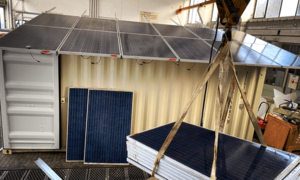February 7, 2022
The "Fiber Optical Sensor Systems" department of the Fraunhofer Heinrich Hertz Institute (HHI), together with the Clausthal University of Technology, has developed the solar-powered "VoltaView Mini-Grid-25" system. The system delivers a cost-effective solution for providing affordable, reliable and clean energy. It is used in sub-Saharan Africa, where many rural villages are not connected to the national power grid.
The VoltaView mini-grid system provides electricity for approximately 50 homes and up to five small businesses, as well as for the purification of 2,000 liters of drinking water per day at affordable prices. It consists of so-called second-life batteries and second-life solar modules, which recycle used batteries and solar modules. Recycling these components, the mini-grid system contributes to establishing a global circular economy and reducing worldwide CO2 emissions. The researchers began building the first container-based VoltaView Mini-Grid-25 at Fraunhofer HHI’s Goslar site in January 2022. In February 2022, the system will be rolled out for the first time in Tanzania to supply remote villages with electricity.
The United Nations Economic Commission for Africa (UNECA) estimates that about 86 percent of people in rural areas of sub-Saharan Africa lack access to electricity. However, electricity is the most important prerequisite for local economic development and for access to clean drinking water. Electrification projects in the region often fail due to financing. Electricity users cannot pay the prices that potential investors need to cover their costs.
The VoltaView team aims to solve this problem with the new mini-grid system. By using discarded solar panels and lithium-ion battery (LIB) storage, researchers can dramatically reduce costs, as these components are the most expensive parts of electricity systems. To ensure the performance of these components, they are independently tested and evaluated with a specific certificate program. The components only receive this certificate if they have a residual capacity or efficiency of more than 85 percent compared to new modules. The estimated service life for second-life components is more than ten years.
In addition to power production, the VoltaView-Mini-Grid-25 includes a water purification system that applies a combination of various filters and UV-C disinfection, a sterilization process using high levels of UV-C radiation. To protect the system from overheating, the researchers developed sensor-controlled louvered windows that cool the container using fresh airflow. Furthermore, the Fraunhofer HHI team equipped the second-life LIB storage system with a sensor-controlled sprinkler system. In the event of an accident, it sprays the fire-extinguishing agent F500 within a few seconds and can thus quickly and efficiently extinguish a lithium-ion battery fire.
The researchers installed the complete system in a sea container and carried out all necessary hardware installations at the Fraunhofer HHI campus in Goslar. At the deployment site, all that remains to be done is to mount the solar panels on the roof of the container.
In addition to Fraunhofer HHI and the Energy Storage Technologies Research Center at Clausthal University of Technology, the project is financially supported by Rotary Club Goslar and Aktion 99 Pfennig e.V.
